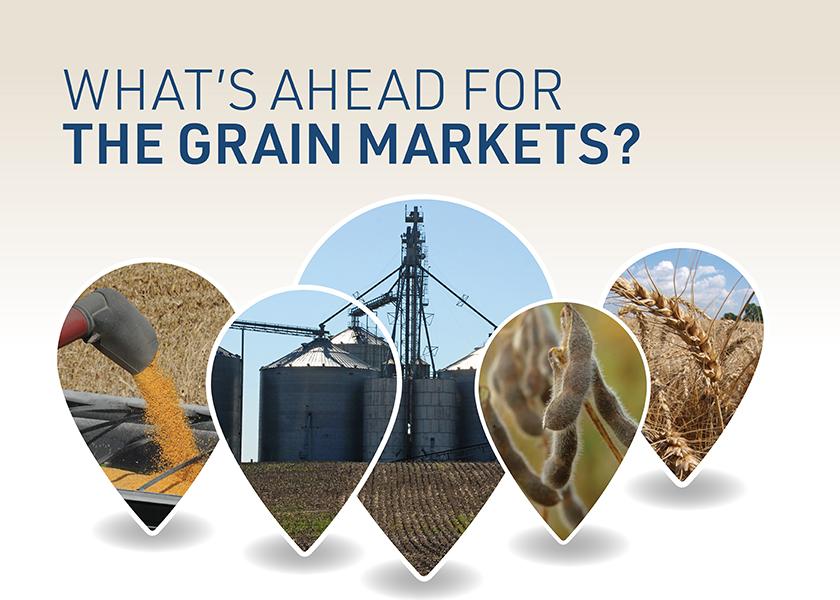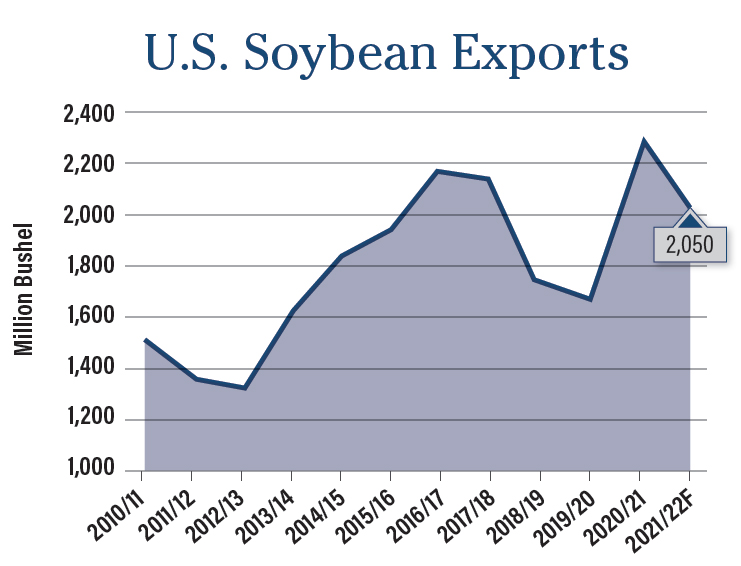Chip Flory: What’s Ahead for the Grain Markets?

“Don’t panic on price slides and sell into rallies.” That was the consensus marketing outlook from several analysts on “AgriTalk” following the 2021 harvest. That advice was common for corn, soybeans, wheat and cotton. Let’s look at the outlook for each market.
CORN MARKET: ALL ABOUT DEMAND
The input price rise seen in the second half of 2021 has growers running the numbers on potential returns on 2022 crops.
Unless corn can increase acres from 2021, corn carryover will remain tight into the 2022/23 marketing year – and likely into the 2023/24 marketing year. Total corn demand this year was up slightly from last year in USDA’s November report. Most impressively, that estimate comes with the national average on-farm cash corn price up 90¢ from 2020/21. (More use at a higher price indicates a real increase in demand.) Here are the highlights:
- Feed and residual use has found a home in the 5.6- to 5.7-billion-bushel range.
- Exports won’t reach last year’s level and will fall about 250 million bushels as China finds alternative feeds and al-ternative sources for feed grains.
The difference is ethanol. Corn-for-ethanol demand in 2019/20 was smashed by COVID-19 and fell 500 million bushels from the year before. A recovery is accelerating, with corn-for-ethanol estimated up 225 million bushels from last year. USDA’s corn-for-ethanol estimate of 5.25 billion bushels could still be 150 million bushels too low.

December 2022 corn futures posted a contract high on Nov. 24, 2021, at $5.65. Most market regions sported basis levels that supported $5.25-plus, fall 2022 delivery cash bids. Throughout 2021, I heard Pro Farmer Editor Brian Grete say, “Corn is too cheap at $5 and too high-priced at $6.” I think I’ll hear that from Brian several times in the year ahead, as well.
THE NEW SOYBEAN STORY
January soybean futures spent two months of fall and early winter trading between $12 and $13. The smaller-than-expected November crop estimate limited “damage” to the soybean balance sheet. When January 2022 soybean futures peaked on June 7, 2021, the market had momentum, demand and supply scares working together to push prices to the $14.79 high.
Soybean prices will be whipsawed by a transitioning soy market in 2022. Until 2021, a soybean-oil-led rally couldn’t be trusted. Now, because of renewable diesel and investment in U.S. soybean crush, traders are getting used to the idea of crushing for oil and potentially being buried by meal.
I’d like to claim knowledge of how this will ultimately impact soybean prices, but it’s a transition I haven’t seen in my 35 years of watching markets.
I’d like to say China will find an appetite for U.S. soybean meal. In reality – that’s not how that market is geared. Chi-na has built a soybean crushing industry it will likely look to support. That means soybean meal will likely anchor soybean prices while soybean oil will lead on price advances.

Here are the trends I am watching:
- A year ago, upside price momentum was building. At the end of November, “sideways” was the only way to define the trend in new-crop soybean futures.
- A year ago, China was buying more soybeans as a hedge in case La Niña clipped Brazilian production. This year, China importers appear confident in Brazil’s soybean supply and are waiting for lower U.S. prices to fill demand holes.
- A year ago, the markets were battling for acres. This year, corn’s rising input prices have the soybean market on the defensive to prevent a big-time switch to soybeans in 2022.
TIGHT SUPPLIES OF WHEAT
Rallies in wheat prices were easy to spark in the fall of 2021. A short Russian 2021 wheat crop triggered supply management and export taxes. The U.S. and Canada saw a terrible 2021 growing season in spring wheat areas. Australia’s big 2021 crop turned into a bust when harvest-season rains turned much of the crop to feed-quality. Finally, U.S. wheat growers saw a less-than-ideal start to the 2022 hard red winter wheat crop.
After five years of building global wheat supplies, stocks have tightened in two of the past three years. With consumption expected to outpace production again in 2021/22, tight global supplies of milling-quality wheat limit down-side price risk and leave the market open to supply- side shocks for at least two more crop years.
The last time U.S. wheat stocks were under 600 million bushels, winter wheat futures traded just over $9. Both old- and new-crop soft red winter (SRW) futures traded above $8.50 in November. Historically, the “so-so” winter wheat crop conditions and a trend of tightening global stocks mean rallies approaching $9 in SRW futures are likely and should be rewarded with new-crop sales.

“AgriTalk” host and Farm Journal Economist Chip Flory has been with Farm Journal for 33 years. He helps farmers understand the markets and seize opportunities.







